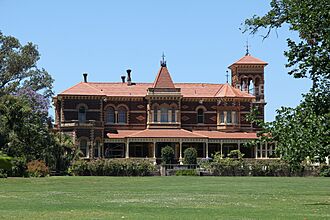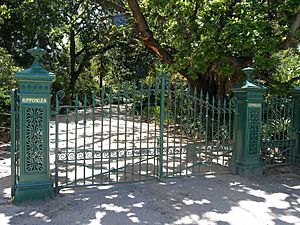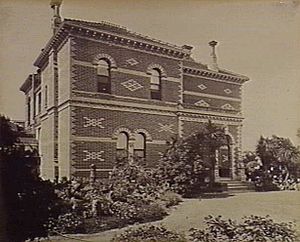Rippon Lea Estate facts for kids
Quick facts for kids Rippon Lea Estate |
|
|---|---|
 |
|
| General information | |
| Location | Elsternwick, Melbourne, Victoria |
| Country | Australia |
| Owner | Sir Frederick Sargood |
Rippon Lea Estate is a special old house and garden in Elsternwick, Melbourne, Victoria, Australia. It's like a museum now, looked after by the National Trust of Australia. This means it's a very important place that needs to be protected for everyone to enjoy. It was added to the Australian National Heritage List on August 11, 2006.
Contents
The Story of Rippon Lea
The Rippon Lea mansion and its beautiful garden were built for Sir Frederick Sargood. He was a very rich businessman and a kind person who helped others in Melbourne.
Building a Dream Home
In 1868, Frederick and his wife, Marion, bought a large piece of land. It was about 8 kilometers from the center of Melbourne. They named their new home "Rippon Lea" after Frederick's mother, Emma Rippon. The word lea means "meadow" in old English.
Frederick hired an architect named Joseph Reed to design their house. It was a big, two-story house with 15 rooms. Around the house, they created a huge garden with glasshouses, vegetable patches, and fruit trees.
A Garden with Its Own Water
What made the Rippon Lea garden special was its clever water system. It had a large, man-made lake that collected rainwater from the surrounding area. This meant the garden could water itself! By the late 1870s, the estate was very large, with the kitchen garden alone being about 2 acres.
The house itself had a unique look with colorful brickwork. Over the years, more parts were added to the house. One big change was turning a glass room into a huge ballroom that could hold 500 people. They also added a large shade house for palm trees.
Modern for Its Time
Rippon Lea was very modern for its time. It was one of the first houses in Australia to have electric lights, made by its own power generators. There was even a full-time electrician to keep everything working. The house also had an electric bell system to call servants.
The Sargoods loved to host parties, charity events, and garden gatherings. The last changes to the house happened in 1897, when more rooms were added, along with a covered entrance for carriages and a tower.
New Owners and Big Changes
After Frederick Sargood passed away in 1903, the property was sold. Developers wanted to break up the land and build smaller houses, as Elsternwick was growing. The house was empty for six years while parts of the land were sold off.
In 1910, Ben and Agnes Nathan bought Rippon Lea. They owned the Maples furniture stores. They lived there until Ben's death in 1935. Then, their daughter, Louisa, inherited the estate.
Louisa, also known as Mrs. Timothy Jones, was a very social person in Melbourne. She made many changes to the house to host grand parties. She redecorated much of the inside, giving it a glamorous 1930s Hollywood style.
A Swimming Pool and a TV Studio
Louisa replaced the old ballroom with a fancy Hollywood-style swimming pool and a new ballroom. She also put in a modern kitchen on the ground floor. The old basement kitchen, which was built in the 1880s, was closed off. This helped to preserve many of its original features, like the cool room and wine cellar. The 14 acres of gardens were still carefully looked after.
In 1954, a part of the property was sold to the Australian Broadcasting Corporation (ABC). This was to build a new television studio for the 1956 Olympic Games in Melbourne. These studios became the ABC's home in Melbourne and were used to make many famous TV shows like Bellbird and Countdown.
Saving Rippon Lea
In 1963, the government wanted to buy a large part of the garden, including the lake. Mrs. Jones fought against this in court. Eventually, she made an agreement: when she passed away, the house and the remaining land would be given to the National Trust. This would keep Rippon Lea safe and whole forever.
Louisa Jones passed away on July 27, 1972. The house finally opened to the public in 1974, allowing everyone to visit and enjoy this historic estate.
Special Features to See
Today, when you visit Rippon Lea, you can see many interesting things. The large lake, the iron-framed fernery (a special greenhouse for ferns), the swimming pool, and the old stable complex from 1868 are all worth exploring.
The basement kitchen area is also very special. It was built in the 1880s and then closed up in 1938. Because it was untouched for so long, it's a rare example of a 19th-century kitchen in Australia. You can see the kitchen, pantries, cool rooms, and even the wine cellar, just as they were long ago.
Images for kids














